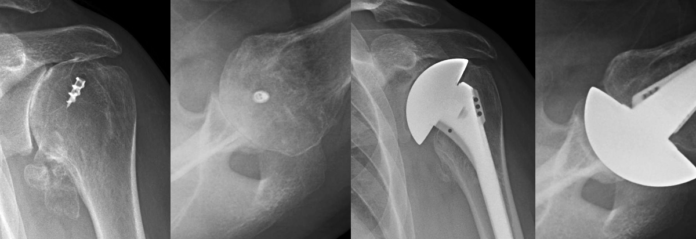A 43 active man elected to have a left ream and run procedure after two previous surgeries:
13 years prior he had an acromioplasty followed by the insertion of a pain pump.
Six years prior he underwent a rotator cuff repair.
Because of his good recovery of left shoulder comfort and function, two years later he elected a ream and run procedure on his previously unoperated right arthritic shoulder

At one year after his right shoulder surgery,
he had good range of right shoulder motion but it was painful.

While the left shoulder showed no evidence of erosion, sequential x-rays of the right shoulder glenoid erosion becoming dramatically worse at six years after the ream and run.

Post op 1 yr 3 yrs 6 yrs
At 6 years post arthroplasty an aspiration showed no fluid

A revision procedure was carried out.
Joint fluid obtained at surgery showed >1,300 WBC, 78% neutrophils
Frozen section of the collar membrane showed neutrophilic infiltration
with >20 WBC per high power field.
In spite of these findings, it was decided to proceed with a revision arthroplasty
After through debridement and irrigation, a reverse total shoulder was performed using the alternative center line without bone graft or base plate augmention.

The patient was placed on Doxycline for 3 weeks until the intraoperative cultures finalized.
At three weeks after surgery the intraoperative cultures and PCR were negative.
Thus, two similar arthroplasties for similar indications in the same patient

wound up with two different treatments.

Two years after revision Ten years after primary
The patient reports “both shoulders are feeling great. I have had no pain since my revision. I am only concerned that I am doing too much with my right. I know that I am more limited with lifting with a reverse so I am making sure I limit what I do with me right side”.
Comment: It is interesting that the glenoid wear occurred on the previously unoperated shoulder rather than on the side with two prior procedures, one of which included the insertion of a pain pump. It is also interesting that even with the high white count of the joint fluid at surgery and the >20 WBC per high power field, the intraoperative cultures were negative. Finally, in spite of the erosion there was sufficient glenoid bone to secure a standard baseplate without bone graft or augment.
Speaking of erosion, here’s the erosion resulting from the retreating Nisqually glacier
Mount Rainier
August 3, 2025

